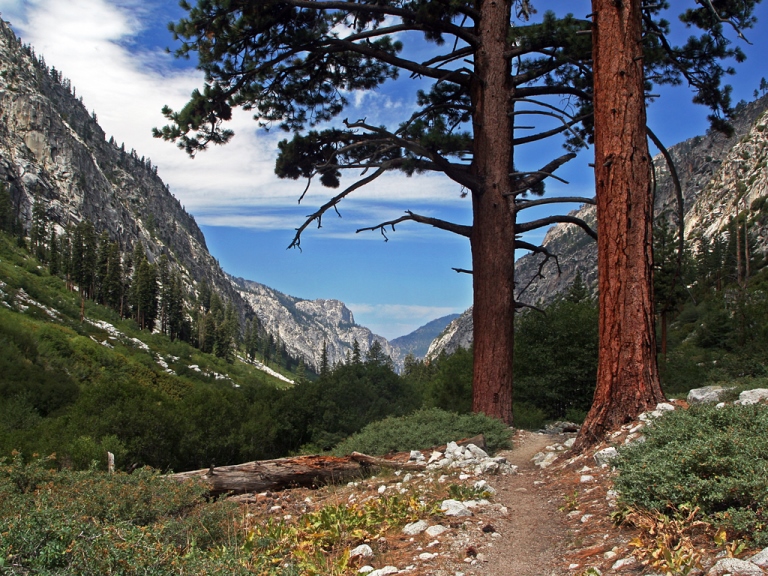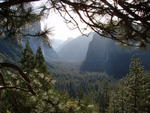
Bubbs Canyon, Kings Canyon National Park
NPS Photo
SEQUOIA AND KINGS CANYON NATIONAL PARKS, CALIFORNIA—The National Park Service has completed the Wilderness Stewardship Plan / Final Environmental Impact Statement (WSP/FEIS) for Sequoia and Kings Canyon National Parks. The final step was taken on May 27, 2015, with the signing of the Record of Decision (ROD) by the National Park Service’s Pacific West Acting Regional Director Patty Neubacher. The WSP/FEIS, the ROD and its two appendices, and additional information is available on the NPS Planning, Environment and Public Comment (PEPC) website at http://parkplanning.nps.gov/sekiwild or by calling Nancy Hendricks, environmental protection specialist, at (559) 565-3102. The WSP/FEIS is available on CD upon request. Printed versions of the WSP/FEIS may be viewed at the Foothills Visitor Center (Sequoia National Park), Giant Forest Museum (Sequoia National Park), Kings Canyon Visitor Center (Kings Canyon National Park), and at local libraries:
• Clovis Regional Library
• Fresno County Libraries: Bear Mountain Branch; Central Branch; Fowler Branch; Kingsburg Branch; Orange Cove Branch; Parlier Branch; Reedley Branch; Sanger Branch; Selma Branch; Sunnyside Branch
• Kern County Libraries: Bakersfield – Beale Memorial Library
• Inyo County Libraries: Big Pine Branch; Lone Pine Branch; Bishop Branch
• Tulare County Libraries: Dinuba Branch; Exeter Branch; Lindsay Branch; Three Rivers Branch; Visalia Branch; Porterville Public Library
• Merced County Libraries: Merced Library
“This plan provides for continued public access and enjoyment of the amazing wilderness areas at Sequoia and Kings Canyon National Parks, while providing park managers with the tools necessary to protect the natural and cultural resources in wilderness,” said Superintendent Woody Smeck of Sequoia and Kings Canyon National Parks.
The development of the WSP/FEIS, a multi-year process, has incorporated substantive input from the public, National Park Service and other wilderness managers, and subject matter specialists. A wide array of management options has been explored and discussed in development of the final methods and actions that will be used to protect the parks’ wilderness for the next 15-20 years. The National Park Service will use the developed framework established by the WSP/FEIS and approved by the ROD to manage the parks’ wilderness to meet the mandates of the Wilderness Act and other associated laws: to preserve wilderness character, to provide opportunities for and encourage public use and enjoyment of the wilderness, and to improve conditions in areas where there may be unacceptable levels of impacts on wilderness character.
The implementation of changes from current wilderness practices and restrictions—especially changes that directly affect public use—will be phased in over the next few years. Phased implementation will provide for adequate opportunities to inform the public of changes the WSP will make in public use and access in wilderness. For example, the campfire limit in the Kern River drainage is slated in the WSP to change from 10,400 ft. to 10,000 ft. For the remainder of 2015, the limit will remain at 10,400 ft. Other aspects of the WSP that will be phased in include changes in party (group) size; night stay limits at specific locations; removal of food-storage boxes; stock feed requirements; implementation of the trail classification system; and changes in commercial service procedures.
Background Information:
The Draft WSP/EIS was available for a 60-day public review period from June 27, 2014, to August 25, 2014. During this time, the National Park Service received 251 public comment letters from individuals, interest groups, businesses, and government agencies. In response to public comments, agency feedback, and new technical information, the National Park Service modified the preferred alternative (alternative 2) between the release of the draft and final plan.
The parks’ total designated wilderness is 808,078 acres — approximately 93.3% of the total park acreage of 865,964. In addition, because the southern end of the Hockett Plateau (approximately 29,500 acres) remains proposed wilderness, it is managed as wilderness, according to law (PL 111-11) and National Park Service policy. The parks also contain several designated potential wilderness additions, including the area around the Pear Lake Ski Hut and Bearpaw Meadow High Sierra Camp. Altogether, designated and proposed wilderness areas comprise nearly 97% of the total acreage of Sequoia and Kings Canyon National Parks.


